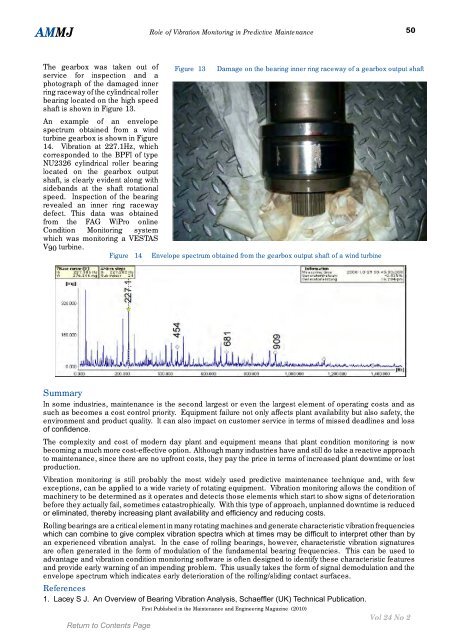April - Library
April - Library
April - Library
You also want an ePaper? Increase the reach of your titles
YUMPU automatically turns print PDFs into web optimized ePapers that Google loves.
AMMJ<br />
The gearbox was taken out of<br />
service for inspection and a<br />
photograph of the damaged inner<br />
ring raceway of the cylindrical roller<br />
bearing located on the high speed<br />
shaft is shown in Figure 13.<br />
Role of Vibration Monitoring in Predictive Maintenance<br />
Figure 13 Damage on the bearing inner ring raceway of a gearbox output shaft<br />
An example of an envelope<br />
spectrum obtained from a wind<br />
turbine gearbox is shown in Figure<br />
14. Vibration at 227.1Hz, which<br />
corresponded to the BPFI of type<br />
NU2326 cylindrical roller bearing<br />
located on the gearbox output<br />
shaft, is clearly evident along with<br />
sidebands at the shaft rotational<br />
speed. Inspection of the bearing<br />
revealed an inner ring raceway<br />
defect. This data was obtained<br />
from the FAG WiPro online<br />
Condition Monitoring system<br />
which was monitoring a VESTAS<br />
V90 turbine.<br />
Figure 14 Envelope spectrum obtained from the gearbox output shaft of a wind turbine<br />
Summary<br />
In some industries, maintenance is the second largest or even the largest element of operating costs and as<br />
such as becomes a cost control priority. Equipment failure not only affects plant availability but also safety, the<br />
environment and product quality. It can also impact on customer service in terms of missed deadlines and loss<br />
of confidence.<br />
The complexity and cost of modern day plant and equipment means that plant condition monitoring is now<br />
becoming a much more cost-effective option. Although many industries have and still do take a reactive approach<br />
to maintenance, since there are no upfront costs, they pay the price in terms of increased plant downtime or lost<br />
production.<br />
Vibration monitoring is still probably the most widely used predictive maintenance technique and, with few<br />
exceptions, can be applied to a wide variety of rotating equipment. Vibration monitoring allows the condition of<br />
machinery to be determined as it operates and detects those elements which start to show signs of deterioration<br />
before they actually fail, sometimes catastrophically. With this type of approach, unplanned downtime is reduced<br />
or eliminated, thereby increasing plant availability and efficiency and reducing costs.<br />
Rolling bearings are a critical element in many rotating machines and generate characteristic vibration frequencies<br />
which can combine to give complex vibration spectra which at times may be difficult to interpret other than by<br />
an experienced vibration analyst. In the case of rolling bearings, however, characteristic vibration signatures<br />
are often generated in the form of modulation of the fundamental bearing frequencies. This can be used to<br />
advantage and vibration condition monitoring software is often designed to identify these characteristic features<br />
and provide early warning of an impending problem. This usually takes the form of signal demodulation and the<br />
envelope spectrum which indicates early deterioration of the rolling/sliding contact surfaces.<br />
References<br />
1. Lacey S J. An Overview of Bearing Vibration Analysis, Schaeffler (UK) Technical Publication.<br />
First Published in the Maintenance and Engineering Magazine (2010)<br />
50<br />
Vol 24 No 2
















